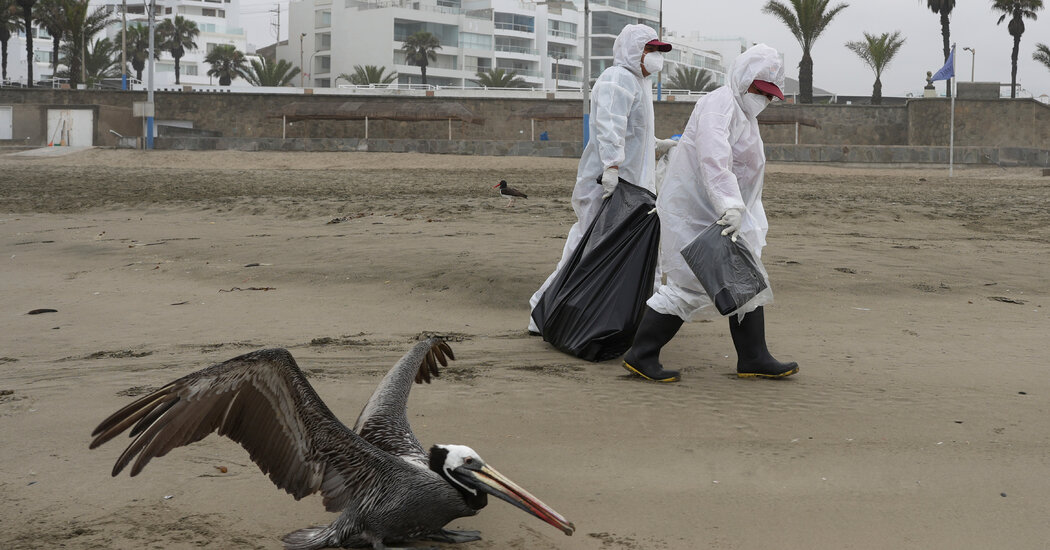The bird flu outbreak in dairy cattle has so far spilled over to just three farmworkers in the United States, as far as public health authorities know. All of them have had mostly mild symptoms.
But that does not guarantee that the virus, called H5N1, will remain benign if it begins to spread among people. Accumulating evidence from the animal world and data from other parts of the globe, in fact, suggest the opposite.
Some dairy cows never recovered from H5N1, and died or were slaughtered because of it. Infected terns seemed disoriented and unable to fly. Elephant seal pups had trouble breathing and developed tremors after catching the virus. Infected cats went blind, walking in circles; two-thirds of them died.
“I definitely don’t think there is room for complacency here,” said Anice Lowen, a virologist at Emory University.
“H5N1 is a highly pathogenic type of influenza virus, and we need to have a high degree of concern around it if it’s spilling over into humans,” she said.
In ferrets experimentally inoculated with the virus through their eyes — the presumed route of infection in the U.S. farmworkers — the virus rapidly spread to their airways, lungs, stomach and brain, according to a report published on Wednesday.
Other studies have found similar patterns in mice fed contaminated milk. The findings suggest that entry through the eyes or digestive system ultimately may not make the virus any less a threat.
H5N1 has shown itself to be promiscuous, rapidly gaining new hosts — wild birds and poultry, mice and bears, cats and sea lions. Since its discovery in 1996 in Hong Kong, it has also infected nearly 900 people.
An older version of the virus circulating in Asia has killed about half of those infected.
Of the 15 people known to have been stricken with the version that is now circulating in cattle, one in China died and another was hospitalized. Two patients in Chile and Ecuador had severe symptoms. Four Americans — one last year and the three infected with the latest outbreak — have fared better.
Crucially, no forms of the bird flu virus seem to have spread efficiently from person to person. That is no guarantee that H5N1 will not acquire that ability, said Yoshihiro Kawaoka, a virologist and bird flu expert at the University of Wisconsin-Madison.
“I think the virus is clearly changing its property, because we never saw outbreaks in cows,” Dr. Kawaoka said. Conjunctivitis, also known as pink eye and the primary symptom in two of the three farmworkers, is not typical of H5N1 infection. The appearance of the virus in mammary glands — in cattle and even in non lactating mice — was also unexpected.
The worry now is that as H5N1 continues to infect mammals and evolve, it may pick up the mutations needed to spread efficiently among people, setting off another pandemic.
The incubation period for flu is two to four days, and a human-to-human version could spread far before cases were detected, said Erin Sorrell, a virologist and a senior scholar at the Johns Hopkins Center for Health Security.
“If it goes into the general public, it’s too late,” she said. “We’ve missed the boat.”
Flu is typically most severe in older adults and children under 5. (An outbreak of swine flu in 2009 was not as devastating as feared, yet it killed nearly 1,300 children.) The severity of illness also depends on how much virus the infected patients are exposed to and for how long, as well as the route of entry and their genetic background and general health.
Infected people generally have fever and respiratory symptoms; some cases advance quickly to pneumonia or death. If the bird flu virus were to adapt to people, the world would need billions of doses of vaccines and antivirals to stave off these outcomes.
The federal stockpile holds four types of flu antivirals, but the drugs must be taken within 48 hours of symptom onset to be effective. One recent review found too little evidence to gauge the effectiveness of three of the four drugs, including the commonly used oseltamivir, sold as Tamiflu.
Some new versions of H5N1 have mutations that make the virus resistant to oseltamivir and to the other two drugs, but those changes, fortunately, have not been widely transmitted in animal populations. No mutations have been observed against the fourth drug, baloxavir.
But there are only a few hundred thousand doses of that drug in the stockpile, according to David Boucher, the infectious disease director of the federal Administration for Strategic Preparedness and Response.
Vaccines are a better bet to stem a pandemic, but enough doses are not likely to be available for many months, at the least. Even if global production of seasonal flu vaccines were entirely shifted to vaccines against H5N1, the number of doses manufactured would be enough for fewer than two billion people, assuming two doses were needed for each person.
In the United States, the national stockpile holds hundreds of thousands of vaccine doses that could be rolled out to those at risk, including children. Companies contracting with the government could make more than 100 million doses in the first 130 days, Dr. Boucher said.
Officials recently announced that they had taken steps to ready 4.8 million doses that could be bottled without disrupting seasonal flu vaccine production.
But most of these plans will help only if the virus cooperates.
Since H5N1’s first appearance, it has branched into many forms, and scientists have created a library of 40 so-called candidate vaccine viruses to match. Having them ready to go saves crucial time, because creating a new candidate can take three months, said Todd Davis, a virologist at the Centers for Disease Control and Prevention.
So far, he said, the virus has changed only minimally, especially the part of the virus that binds to human cells, called hemagglutinin or HA.
If the virus were to spread among people, it would first have to change significantly, some experts noted. “If this virus jumps into humans, you can bet that the HA is going to change, because right now the HA of this virus does not bind very effectively to human cells,” said Scott Hensley, an immunologist at the University of Pennsylvania.
Traditional flu vaccines are made by growing candidate viruses in eggs or in mammalian cells, both of which are fraught with potential problems: The virus may not grow quickly enough, or it may mutate too much as it grows.
In 2009, the candidate virus grew well in eggs but evolved into a poor match for wild H5N1 virus, introducing long delays in distribution to the public. “By the time the vaccine stocks were made and distributed, the initial wave of pandemic had already subsided,” Dr. Hensley said.
CSL Sequiris, a leading manufacturer of seasonal flu vaccines, has a cell-based H5N1 vaccine that is already approved by the Food and Drug Administration.
In the event of a pandemic, once CSL receives a candidate vaccine virus that matches the circulating virus, it could provide 150 million doses for Americans within six months, said Marc Lacey, an executive director at the company. (The firm also has contracts with 19 other countries.)
But 150 million doses would protect only about one in five Americans. Federal officials also are exploring mRNA bird flu vaccines, which could be made very quickly, as the Covid pandemic illustrated, to protect both cows and people. Dr. Hensley’s team is testing an mRNA vaccine in cows.
Officials have hesitated to deploy vaccines for cows because of trade concerns, experts said: Some countries bar imports of products from vaccinated birds and animals.
But immunizing cows would curb the risk to farm workers, and to other cows, and limit the opportunities for the virus to keep spreading and evolving, experts said.
So far, federal officials have also been reluctant to vaccinate farm workers, saying that the risk is still low.
The real danger, Dr. Lowen of Emory said, is if a farmworker becomes infected with both H5N1 and a seasonal flu virus. Flu viruses are adept at swapping genes, so a co-infection would give H5N1 opportunity to gain genes that enable it to spread among people as efficiently as seasonal flu does.
The possibility underscores the importance of vaccinating farmworkers, Dr. Lowen said: “Anything we can do to limit seasonal infection in people that are occupationally exposed to H5N1 could really reduce risk.”



